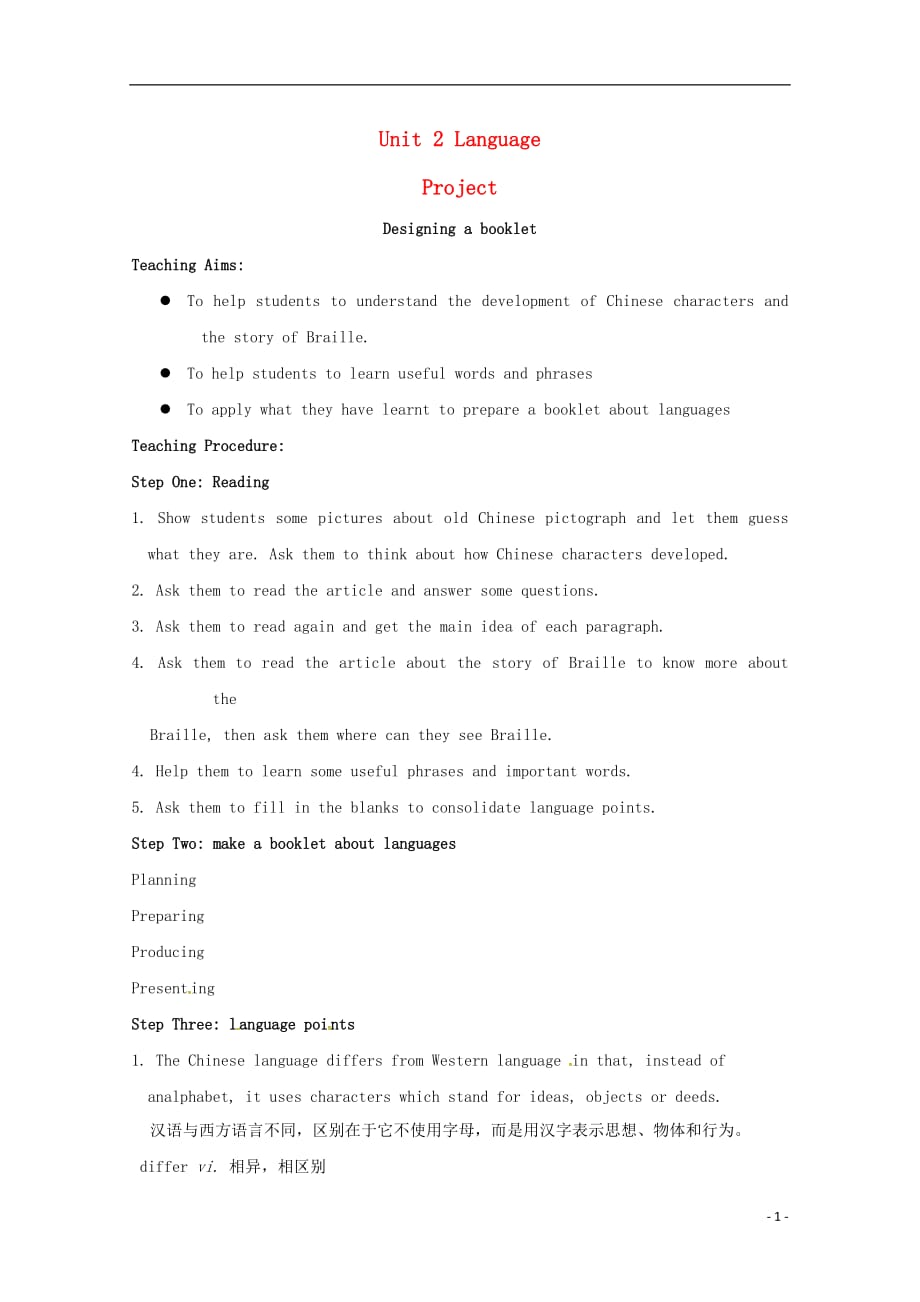《湖南省茶陵縣高中英語 Unit 2 Language Project教案 牛津譯林版必修3》由會(huì)員分享��,可在線閱讀���,更多相關(guān)《湖南省茶陵縣高中英語 Unit 2 Language Project教案 牛津譯林版必修3(3頁珍藏版)》請(qǐng)?jiān)谘b配圖網(wǎng)上搜索�����。
1�����、
Unit 2 Language
Project
Designing a booklet
Teaching Aims:
l To help students to understand the development of Chinese characters and the story of Braille.
l To help students to learn useful words and phrases
l To apply what they have learnt to prepare a booklet about languages
Teaching
2��、Procedure:
Step One: Reading
1. Show students some pictures about old Chinese pictograph and let them guess what they are. Ask them to think about how Chinese characters developed.
2. Ask them to read the article and answer some questions.
3. Ask them to read again and get the main idea of each
3�����、paragraph.
4. Ask them to read the article about the story of Braille to know more about the
Braille, then ask them where can they see Braille.
4. Help them to learn some useful phrases and important words.
5. Ask them to fill in the blanks to consolidate language points.
Step Two: make a book
4����、let about languages
Planning
Preparing
Producing
Presenting
Step Three: language points
1. The Chinese language differs from Western language in that, instead of analphabet, it uses characters which stand for ideas, objects or deeds.
漢語與西方語言不同,區(qū)別在于它不使用字母��,而是用漢字表示思想�、物體和行為。
differ v
5�����、i. 相異�����,相區(qū)別
differ from 和……不同����,不同于
e.g. China differs greatly from the USA in politics and culture.
= China is very different from the USA in politics and culture.
中國和美國在政體和文化方面有很大的不同��。
stand for 代表�,象征,擁護(hù)
e.g. UN stands for the United Nations.
UN是聯(lián)合國的縮寫�����。
John alwa
6�����、ys stands for what is right.
約翰一貫支持正確的事情。
2. Then he had the idea that he could use different shapes to represent different objects.
于是他想到可以用不同的形狀來代表不同物體�����。
represent vt. 代表���,展示
e.g. He represented himself to be the Son of God. 他自稱是救世主��。
His opinion represents that of the majority.
7�����、 他代表了大多數(shù)人的觀點(diǎn)�����。
3. Some characters have been simplified and others have been made more difficult over time.
一些漢字被簡化了����,而另一些則變得更加復(fù)雜�。
simplify vt. 簡化
e.g. Try to simplify your explanation for the children.
試著簡化你對(duì)孩子們所作的解釋。
4. However, as a whole, the characters have developed from drawings into
8、 standard forms.
不過總的來說�,漢字從圖畫發(fā)展成了標(biāo)準(zhǔn)形式。
as a whole 總的來說�,總體上
e.g. As a whole, it is very hot in Nanjing during the summer.
總的說來,南京的夏天相當(dāng)熱����。
5. Sometimes to express ideas, some characters were made by combining two or more characters together.
有時(shí)為了表達(dá)概念,某些漢字由兩個(gè)或多個(gè)漢字組合而成�����。
combine vt./vi. 組合�����;(使
9�����、)聯(lián)合
e.g. The two countries combined together against their enemy.
這兩個(gè)國家聯(lián)合起來對(duì)抗他們的敵人�����。
6. Though these kinds of characters indicate meanings, one of their shortcomings is that they do not show how they should be pronounced.
雖然這幾種類型的漢字能夠表意��,但是它們的缺點(diǎn)之一是其字形不具有表
音的功能���。
indicate vt. 顯示��,暗示��,象征
e.g. T
10��、he sign at the entrance indicates that there are bears in the mountains,
so visitors should be careful.
入口處的指示牌標(biāo)明山中有熊�����,所以游客需要當(dāng)心����。
Researches indicate that the wide use of computers has changed the way of life of many young people.
研究表明�����,電腦的廣泛使用改變了許多年輕人的生活方式���。
Step Four: Homework:
Do parts B1 and B2 on Page 99
Do parts D1 and D2 on Page 101
Review the words and phrases in this unit
- 3 -
 湖南省茶陵縣高中英語 Unit 2 Language Project教案 牛津譯林版必修3
湖南省茶陵縣高中英語 Unit 2 Language Project教案 牛津譯林版必修3

